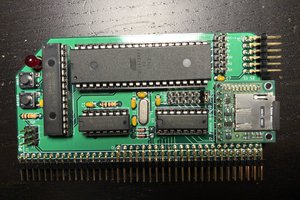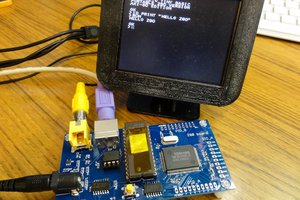If you ever thought about making a Z80-based card system, here is one made in the 1980s and used commercially. It had its own newsletter with quite a few subscribers.
The unique selling point was that it used only readily available chips, so the user would always be able to get the parts.
I considered creating a project page for each of the many items, but don't have the time.
The original author and designer, Dave Parkins, has granted permission to preserve his work in electronic form.
Ideally I would convert everything into html where they can be viewed with a browser with colour images and hyperlinks etc.
In practice I have limited free time, there is enough here to keep me busy past retirement.
Best quality conversions are in html.
Second best quality is scanned pages held in html.
This allows documents to be partially converted through OCR, as time allows.
Where I was lent paper documents to scan, I scanned them to black-and-white indexed 600-dpi png files. PNG is not as compressed as TIF CCITT group 4, but png files are directly viewable in a browser.
Some documents where given to me as jpeg files in a pdf file.
Jpeg is a bad choice of format, because it ends up storing lots of low-frequency detail of page backgrounds and introduces blurry artefacts around text.
Such pdf files could be 40 instead of 7 megabytes. It is possible to extract the jpg files and threshold them into black-white png files.
I have sometimes done this to get files into more manageable size.
Some scans have such low resolution that they are not easy for the human eye to read and also for machines to OCR. They will need careful human work to restore to text files.
Ideally they would be re-scanned, if the originals can be found.
On a positive note, modern technology allows boards to be photographed and scanned in high quality. These can replace poor-quality scans of photocopied images in manuals. I was recently loaned some unpopulated boards, and the scans allow those boards to be recreated by a sufficiently keen person.
Some boards are redundant today, as one can now get memory chips as big and bigger as any of the memory boards. Parallel keyboards, parallel port printers, tape, and floppy disks, have largely gone. However, these documents form a historical record of the product technology of its day. I hope they will also be interesting and educational.
You will need to create a top-level directory (called Greenbank for example) and unzip the top-level zip file into it. This provides the style sheet and index page. Next download the zip files of the items that interest you, and unzip them into sub-directories of the same name. e.g.
Greenback/MZB3.zip
should unzip into directory
Greenback/MZB3
If you have any problems, let me know. Worst case, I can send you a CD ROM.
The zip files cover:
Interak Bus description.
Interak General Description.
Interak System Notes.
Interak System 1 Description.
Z80 processor boards.
Z80 based video board.
Programmable Character Generator for the above.
14K RAM/ROM board.
Dynamic RAM cards, 16K and 64K.
Dual Tape Interface.
Floppy Disk Drive.
Latched Keyboard Port.
Parallel Printer Port.
Programmable Sound Generator.
Quad Serial board.
EPROM programmer board.
Memory-mapped PROM Programmer.
DIP chip prototyping board.
Floppy Disk Controller.
Real Time Clock board, using MC146818 chip.
Relay Output Board.
Serial board using the 6402. Photos only.
Serial Communications board. No manual or data sheet, just circuit sketches.
Bus extender card.
Tape Cassette Player.
Power Supply Distribution.
Z380 project initial design notes.
Software
Z80 monitors, manual and source code.
Z80 BASIC and Manual.
DMON Disk Monitor. Manual, source code and listing.
CP/M details
CP/M+ User Manual
Hi-Soft Development package.
Mechanics
3U rack assembly instructions.
Deluxe Diplomat Metal Case Assembly
Aztec CPU AC9251 Data and Mounting.
Video Display Terminals, with Keyboards.
Literature Request.
Interak Price List
Interak I/O Port map
 Keith
Keith
 J.B. Langston
J.B. Langston
 Rob Ward
Rob Ward
 kodera2t
kodera2t
 Denver
Denver